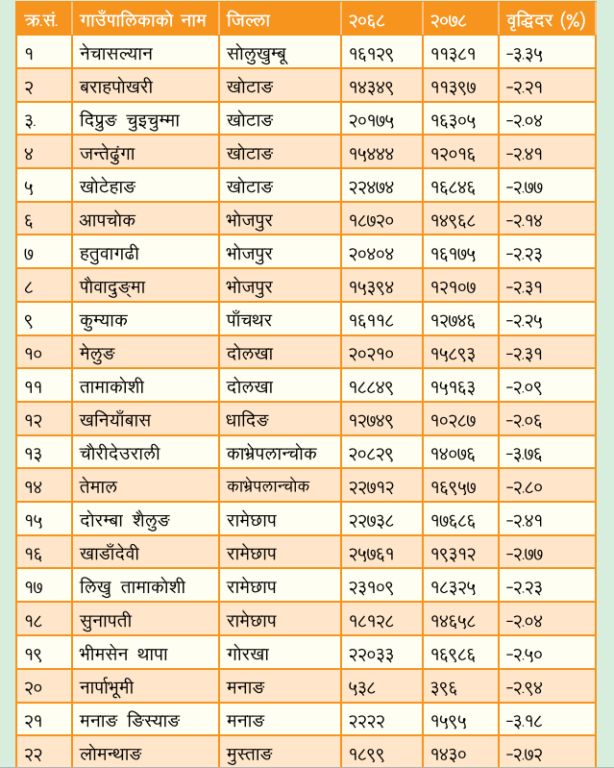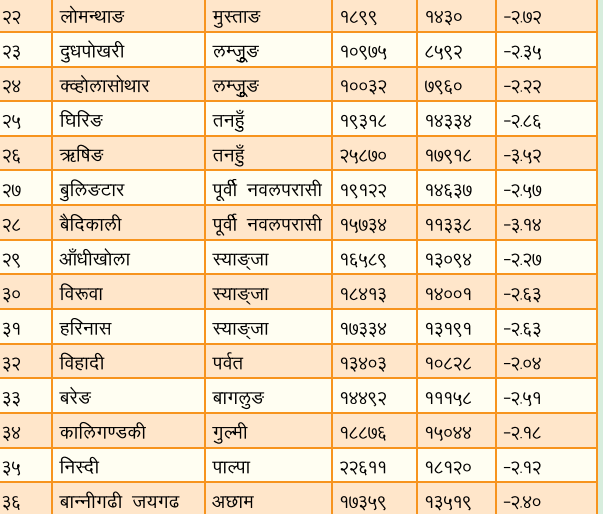Kathmandu – The population growth rate of 36 rural villages in the Himalayan and Hilly regions has been observed to decrease rapidly. In the decade from 2068 to 2078, these rural municipalities experienced a population loss of 2% to 3.5% every year. According to the results of the census released by the National Statistics Office, there is a rapid decline in population in rural villages in the Himalayan and hilly regions. Nechasalyan of Solukhumbu is the rural municipality that has witnessed the largest population decline in this decade. In the 2068 census, the population there was 16,129, but in 2078, it decreased to 11,381. The annual population growth rate there is -3.35%. Similarly, the population of Khotang rural municipality has decreased by 2.77%. In 2068, there was a population of 22,474, while in 2078, it was only 18,844. The table clearly indicates how much the population has decreased in each municipality.


What is the reason for the rapid decline in population? Transportation facilities have reached rural areas. Schools are open, and food is bought and sold in the village. With the availability of transportation, traditional fruits and vegetables have also started finding markets. Consequently, people have started earning money, including employment opportunities in the village. But why are people leaving their homes in the mountains and relocating to other places? There are various reasons for this. People do not suddenly leave their old homes and settle in new places. However, there are challenges in our mountains. With time, the current development has failed to meet people’s growing aspirations. Development follows traditional patterns, but people’s desires are evolving rapidly. As a result, when the aspirations of people in the village are not met, the trend of migration increases, says Gita Gurung Kheva, vice president of Chhathar Jorpati Rural Municipality, Dhankuta. According to Kheva, no matter how hard people try to stop them, they turn their attention towards the Terai and leave the village. Experts also suggest that another reason why people leave their village homes and migrate to the Terai and cities is foreign employment. According to a study conducted by sociologist Ganesh Gurung a few years ago, it was found that when youths return from foreign employment, they do not return to their old villages but move to cities or the Terai. Gurung’s experience revealed that the villages in the Himalayas and hilly areas have been affected by the practice of making their wives and children temporarily migrate to the city or the plains when they return from foreign employment for the first time, and later making them stay at home. “Until the number of young people going for foreign jobs is reduced, the process of emptying villages will not stop,” Gurung had said some time ago. Local residents claim that the declining population in 34 districts of the country, as well as the declining population in many municipalities in the hilly regions, has created social upheaval. They also note that social arrangements have started to break down due to irregular migration.

According to Hari Magar of Simta Rural Municipality in Surkhet, certain communities are no longer found in some places. As a result, there is a problem of not finding a Brahmin to perform Shraddha or a tailor to sew clothes. The reasons behind people’s hearts being broken are not easily understood. But after witnessing the influx of people from Bardiya and Kailali, it feels as if people are leaving the villages or staying. Magar suggests that there should be programs from the municipality, state government, and federal government to retain people in the villages. He emphasizes the importance of identifying why people are migrating and finding appropriate solutions.

प्रतिक्रिया